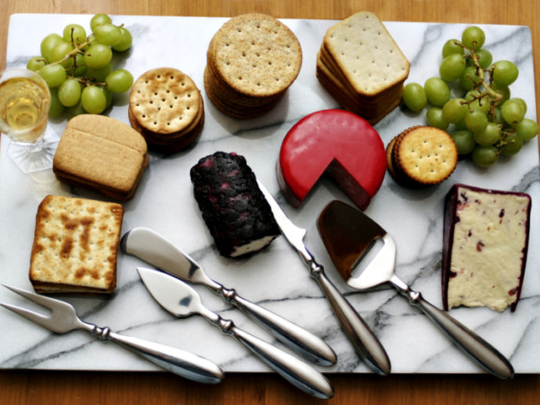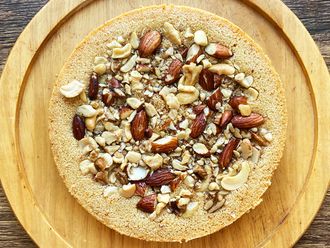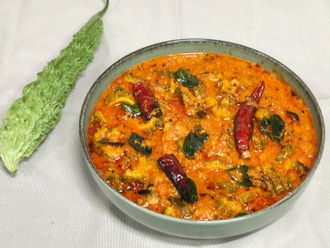
Food gifts for children to make, Claire Thomson
Panforte
This fabulous chocolate confection is an Italian Christmas favourite, and a great homemade festive gift. Yes, there’s a long line-up of ingredients, but don’t let that put the children off: any grandparent, aunt or uncle (or mum or dad, for that matter) would be more than happy with this dense, bitter sweet chocolate cake studded with candied fruit and nuts. It’s best eaten after the big meal with a coffee. Makes about 20 slices.
Ingredients
Vegetable oil, for greasing
40g unsweetened cocoa powder, plus extra for dusting
100g bitter chocolate, chopped
300g mix of toasted almonds and hazelnuts, coarsely chopped
100g plain flour
200g candied mixed peel, chopped
A pinch of salt
1 tbs ground cinnamon
2 tsp ground ginger
1 1/2 tsp freshly ground black pepper
1/4 tsp freshly grated nutmeg
200g caster sugar
200g clear honey
Icing sugar, for dusting
Steps
Heat the oven to 150C. Line the base of a 22 centimetres cake tin with oiled parchment paper, and dust the base and sides with cocoa powder.
In a small bowl set over a pan of simmering water, melt the chopped chocolate. In a large bowl, mix the cocoa, nuts, flour, candied peel, salt and spices. Gently heat the sugar and honey in a pan until the sugar has dissolved, then cook over a higher heat for three minutes. Pour the syrup and melted chocolate into the nut mixture and stir to combine: it will be very sticky (and what child doesn’t like that?).
Use a firm spatula to scrape the mix into the prepared tin and, once cool enough, wet your hands and smooth the top so the surface is flat and even.
Bake for 35-40 minutes. To check it’s ready, touch the top with a finger: if it comes away clean from the surface, the panforte is done. Remove from the oven and leave to cool in the tin.
Turn out the panforte, peel off the greaseproof paper and dust the top with icing sugar, rubbing it all over with dry hands so the cake is completely covered and white.
The panforte can be stored in a lidded tin for up to a month. To serve, cut into thin slices with a large sharp knife. (The cutting will take some force, so be careful.)
Candied and crystallised orange peel
Candied peel is more than just a baking ingredient; it makes a pretty and delicious gift, too. It takes a day or two for the peel to dry, so plan ahead. And if you want to turn these into a properly decadent grown-up sweetie, dip them in chocolate: simply melt some good-quality dark chocolate, dip in the crystallised and candied peel and leave to dry on a greaseproof paper-lined tray. This is a great way to use up the skins from juiced oranges (some recipes say to remove the pith, but I prefer to leave it on).
Ingredients
2 large oranges, or 4 juiced orange halves (see note above)
375g sugar
Water
Steps
If you’re using orange halves left over from juicing, cut each half into six vertically; if you’re using whole oranges, cut each into six, and remove (and eat) the flesh, to leave six segments of peel and pith.
Bring a large pot of water to a boil, cook the segments for 15 minutes and drain. Refill the pot with fresh water, bring to a boil, cook the segments for another 15 minutes, and drain again.
In a separate pan, bring 300 grams of sugar and 300 grams of water to a boil, turn down the heat to medium and stir to dissolve the sugar.
Add the peel to the syrup. Return to a boil, then turn down the heat and simmer until the peel is soft and translucent: 45 minutes to an hour.
Drain and leave the candied peel to cool (reserve the orange-flavoured syrup for use in cake baking or to spoon over plain yoghurt). Once cool, put the remaining 75 grams of sugar in a clean plastic bag, add the candied peel and shake to coat. Lift out the peel, lay it out flat on a sheet of greaseproof paper and set aside until the coating is completely dry — this should take one to two days. Store in an airtight container.
Earl Grey and orange prunes
These are fantastic with blue cheese or as an impromptu pudding with a dollop of double cream and a biscuit. These are a cinch to make, and the flavours are anything but ordinary. Makes two 450ml jars.
Ingredients
400ml hot weak Earl Grey tea
40g soft brown sugar
250g Agen prunes (or other large good-quality prunes), stoned or stone-in, as you prefer
150ml orange juice
2 bay leaves
Zest of 1 orange
1 cinnamon stick
1 vanilla pod, split lengthways
2 450ml airtight jars, cleaned
Steps
Make the tea, add the sugar, stir to dissolve and leave to cool. Put the prunes in a tub for which you have a lid, pour the tea over them, cover and soak overnight (there’s no need to put them in the fridge).
Next day, strain off the liquid into a saucepan, add the orange juice and the remaining ingredients and bring to a boil. Turn down the heat and simmer for five minutes.
Divide the prunes between the two jars, then pour over the syrup evenly, making sure the prunes are totally immersed in liquid. Seal the jars and store in the fridge.
The prunes will improve the longer you leave them, and they’ll keep in the fridge for up to three months.
— Claire Thompson is co-owner of Flinty Red restaurant in Bristol and author of Five O’Clock Apron, a blog on cooking with and for children.
Festive freezer standbys, Hugh Fearnley-Whittingstall
Parsnip and ginger soup
Sweet parsnips and fiery ginger make a fantastically warming winter combo.
Four to six servings
Ingredients
1 tbs olive oil
15g butter
1 large onion, peeled and finely chopped
2 garlic cloves, peeled and finely chopped
4-5cm piece fresh ginger, peeled and finely chopped
1/4 tsp ground cardamom
1/4 tsp ground cumin
1/4 tsp cayenne pepper
500g parsnips, peeled and cut into 1cm cubes
800ml vegetable stock
Sea salt and freshly ground black pepper
To finish
200ml whole milk
2-3 tbs flaked almonds or pumpkin seeds
1/2 tbs double cream or thick yoghurt
Steps
Heat the oil and butter in saucepan over a medium-low heat and sauté the onions for about 10 minutes, until soft and translucent. Add the garlic, ginger, cardamom, cumin and cayenne, and stir for a couple of minutes. Tip in the parsnips and stir until coated in the spices. Add the stock, season and simmer until the parsnips are very soft, about 15 minutes. Cool slightly. Purée in a food processor, blender or with a stick blender. Leave to cool, then freeze.
To serve, defrost the soup, reheat it slowly, then add the milk, adjust the seasoning and warm through gently; if it’s a bit thick, thin with some hot water from the kettle.
While the soup is warming, toast the almonds or pumpkin seeds in a dry frying pan until just beginning to turn golden. Serve the soup in warmed bowls with a trickle of cream or yoghurt and the toasted almonds scattered over the top.
Potato boulangère
Delicious with franks or chops, I also like this with some big field mushrooms baked with a little butter, garlic and cheese.
Four servings.
Ingredients
30g butter
2 onions, peeled, halved and thinly sliced
2 garlic cloves, peeled and sliced
About 1kg slightly waxy potatoes such as maris peer or desiree, peeled and sliced to the thickness of a 10p piece
1/4 tsp chopped thyme leaves
3 sage leaves, finely chopped
About 1.2 litres vegetable stock
Sea salt and freshly ground black pepper
Steps
Heat the oven to 180C. Melt the butter in a heavy-based frying pan and use some of it to grease a large gratin dish. Add the onions to the pan and sauté over a medium heat for 10-15 minutes, until nice and soft, then add the garlic and cook gently for a minute or two.
Spread out one-third of the potatoes in the gratin dish, season generously, then add half the onions and half the herbs. Add a second layer of potatoes, then the remaining onions, then a final layer of potato.
Bring the stock to a simmer. Add salt and pepper to taste, and pour over the potatoes: you want them to be only barely covered, so don’t add it all if you don’t need to. Cover with foil and bake for 30 minutes, then uncover bake until the spuds are just cooked: another 20-30 minutes. Leave to cool, then cover and freeze.
To serve, once completely defrosted, cover with foil and reheat gently in a low oven (around 150C) until the liquid is simmering and the potatoes are hot all the way through. Remove the foil and, if the liquid is still covering the veg, skim a little off the top. Put under the grill briefly, so the top can brown, and serve piping hot.
Stuffings, Hugh Fearnley-Whittingstall
Pear, pecan and blue cheese stuffing
I usually serve this as an accompaniment, rather than stuffing it inside a bird. It also works well as a vegetarian element in a Christmas spread.
Four to six servings.
Ingredients
15g butter, plus extra to finish
1 tbs olive oil
1 large onion, peeled and chopped
2 tender celery stems, chopped
2 cloves garlic, peeled and chopped
1 medium-ripe pear, peeled, cored and cut into 5-10mm cubes
50g wholemeal breadcrumbs
100g pecans, coarsely chopped
1 tsp thyme leaves
75g well-flavoured creamy blue cheese, such as Perl Las or Harbourne Blue, crumbled or chopped
Sea salt and freshly ground black pepper
Steps
Heat the oven to 180C. Lightly butter a square 20 centimetres baking dish or similar. Heat the butter and oil in a frying pan. Add the onion and celery, and sweat gently until soft and translucent, about 15 minutes. Stir in the garlic, cook for a few minutes, take off the heat and leave to cool.
Combine the onion mixture with the pear, breadcrumbs, pecans and thyme, stir in the cheese, and season to taste. Pack into the buttered dish, dot with a little more butter and sprinkle with a little black pepper, and bake for 25-30 minutes, until golden brown on top.
Gravy, Simon Rimmer
One for meat eaters, one for vegetarians. Both serve 10-12.
Meat gravy
You can apply the principle to any roast meat. I roast my turkey on abed of vegetables, to get extra flavour both into the bird and, especially, the gravy. Make it while the turkey is resting.
Ingredients
2 tbs flour
50ml port
150ml chicken stock
Salt and pepper
Steps
Spoon 90 per cent of the fat out of the turkey roasting tin, put the tray on the stovetop and, on medium heat, mash the roasted veg and any scraps of meat into the juices. Add the flour, cook for five minutes, to create a sort-of-roux, add flavoured stock and bring to a boil. Simmer for 15 minutes, adjust the seasoning and strain into a jug or gravy boat.
Vegetarian gravy
Ingredients
A little vegetable oil
6 onions, peeled and sliced
1 clove garlic, peeled and crushed
3 tbs tomato purée
2 tbs vegetarian gravy browning (or soya sauce)
1 450ml can bitter
1 tbs sugar (or honey)
200ml stock
2 tbs butter
Steps
Heat the oil in a large, deep-sided pan, and gently fry the onion and garlic for 12 minutes, until soft and golden. Stir in the tomato purée and cook on a low heat for six minutes. Add everything else except the butter, bring to a boil and reduce for 15-20 minutes. Purée the gravy, return to the pan and bring back to a boil. Whisk in the butter and serve.
— Simon Rimmer is chef-patron of Earle and Greens, both in Manchester, and co-presenter of Sunday Brunch on Channel 4. His latest book, Men Love Pies, Girls Like Hummus, is published by Mitchell Beazley at £16.99 (Dh102). To order a copy for £13.59, including free p&p, go to Theguardian.com/bookshop or call 0330-3336846.
12 Roast potatoes, Heston Blumenthal
Roast potatoes just the way I like them, with a crisp, glass-like crust and a fluffy interior. Don’t stint on the oil: it is the fat gathering in the cracks that makes the potatoes so crisp. And it is important to boil the spuds until they are starting to break apart.
Six servings.
Ingredients
1.25kg large maris piper potatoes
1 whole head of garlic, separated into cloves and each bashed once with the flat of a knife (or by hand)
35g rosemary sprigs
Beef dripping
Olive oil
Salt
Steps
Heat the oven to 180C. Wash and peel the potatoes, and cut them into quarters. Put the peeled spuds into a bowl, place in the sink under the cold tap and leave under cold running water for five minutes, to wash off the starch.
Cover the potatoes with water in a large saucepan, add half the garlic cloves and 30 grams of the rosemary, and bring to a boil. Cook until the potatoes are very soft and beginning to break apart (about 25-30 minutes). Drain carefully (you don’t want them to break up) and leave to cool in the colander (pick out the garlic).
Pour beef dripping and olive oil (50:50 ratio) to a depth of 5 millimetres into a roasting tray large enough to hold the potatoes in one layer, and heat in the oven for 15 minutes.
Add the potatoes to the tray, stir gently to coat in the hot fat and return to the oven for at least an hour and 15 minutes, gently turning every 20 minutes, until the potatoes are golden brown and crisp all over.
After the spuds have been cooking for an hour, add the remaining rosemary and garlic, stir and return to the oven for 15 minutes. Drain on kitchen paper and season with salt.
— Heston Blumenthal is chef-patron of The Fat Duck and The Hinds Head in Bray, and Dinner by Heston Blumenthal in London. His latest book, Historic Heston, is published by Bloomsbury at £125. To order a copy for £75, including free UK mainland p&p, go to Theguardian.com/bookshop or call 0330-3336846.
A vegetarian alternative, Simon Hopkinson
Tomato curry
The Christmas feast is essentially a tarted up Sunday roast, that most British of meals, but curry doesn’t lag far behind in the national popularity stakes. This isn’t just one of my favourite vegetarian dishes; it’s one of my favourite dishes full stop. Serve with a lemony pilau rice and cucumber raita.
Four servings.
Ingredients
1 tbs cumin seeds
1 tbs coriander seeds
10 cardamom pods
1/2 tbs fennel seeds
1/2 tbs black mustard seeds
6 cloves
2 star anise
2 tbs sunflower oil (or other neutral oil)
1/2 tsp ground turmeric
1 tsp sea salt
400ml coconut milk
2 tsp tamarind paste
1 small handful curry leaves
12 medium tomatoes
2 branches fresh green peppercorns
1-2 tsp sugar (depending on the sweetness of the tomatoes)
6-7 healthy sprigs coriander
Steps
In a frying pan, lightly toast the first seven whole spices until aromatic. Heat the oil in a wide, shallow pot, add the toasted spices, fry for a couple of minutes on a medium heat, then add the turmeric and salt. Stir in the coconut milk, tamarind and curry leaves, bring to a simmer and cook for 15 minutes. With a stick blender, blitz the mix for 30 seconds, just to break up the spices, and take off the heat. Skin and core the tomatoes, and pick the peppercorns.
Pass the sauce through a fine sieve and return it to the (washed up) pot. Put the tomatoes in the sauce, removed core side down, and add the peppercorns. Simmer until the tomatoes have softened and the sauce has become a touch thicker: about 15-20 minutes. Taste the sauce to see if it needs a touch of sugar or more salt, stir in the coriander and serve.
Cucumber raita
Ingredients
1 large cucumber, peeled and grated
1 tsp salt
300g plain yoghurt (not Greek)
A little lemon juice
1 clove garlic, peeled, crushed and finely chopped
1 green chilli, deseeded and finely chopped
1 heaped tbs finely chopped mint
Steps
Coarsely grate the cucumber and sprinkle over the salt. Mix well, put into a colander and suspend over a deep bowl. Leave for about 30 minutes, or a bit longer, it matters not. Manually, squeeze out excess moisture from the cucumber, then place it in a bowl and mix in the yoghurt, lemon juice, garlic, chilli and mint. Decant into a serving dish and chill in the fridge for at least 30 minutes.
Lemon pilau rice
Ingredients
40g butter, plus an extra knob to finish
1 small onion, finely chopped
200g basmati rice (I always use Tilda and I don’t wash it first)
320ml water
1 bay leaf
1 small lemon, zest removed with a potato peeler in thin strips and the juice squeezed into a small jug
Salt and freshly ground white pepper
A small knob of extra butter
Steps
Heat the oven to 180C. Melt the butter in a roomy pot that also has a tight-fitting lid. Add the onion and cook gently until lightly coloured. Tip in the rice and stir around a bit until well coated. Pour in the water, add the bay and slowly bring up to a simmer. Meanwhile, finely cut the strips of lemon zest into small slivers and pop in the pot, together with a little salt and pepper. Once the rice is simmering, put on the lid, slide into the oven and cook for 15 minutes.
Remove from the oven, don’t lift off the lid, and leave to sit for five minutes. Now take off the lid, fluff up the rice with a fork while also pouring in the lemon juice. Lay a tea towel over the pan and then clamp the lid on tight. Leave it be for another five minutes; this allows the rice to steam, which will then be absorbed by the towel. Finally, remove the lid and towel — a wonderful, fragrant scent will emanate from the pot — and stir in the knob of butter to glisten the rice.
— Simon Hopkinson’s latest book, Simon Hopkinson Cooks, is published by Ebury at £25. To order a copy for £20, including free UK mainland p&p, go to Theguardian.com/bookshop or call 0330-3336846.
Winter wonderland cake Frances Quinn
This is a magical centrepiece, and lighter than the traditional fruit cake. Apart from a little time spent on the decorations, the cake itself is incredibly easy and quick to make.
For the ginger cake
Ingredients
125g slightly salted butter
125g dark muscovado sugar
125g golden syrup
125g black treacle
250g self-raising flour
1 tsp bicarbonate of soda
2 tsp mixed spice
2 tsp ground ginger
250ml milk
1 large egg
Butter, for greasing
For the decoration
Ingredients
250g white fondant icing
Edible silver balls
100g Mint Imperials
100g Fox’s Glacier Mints
150g desiccated coconut
Icing sugar and silver edible glitter, to dust
Step
Heat the oven to 190C. For the ginger cake, in a large pan over medium heat, melt together the butter, sugar, treacle and syrup, stirring from time to time with a wooden spoon. Once everything has dissolved and combined, remove from the heat and set aside to cool slightly.
Meanwhile, sift all the dry ingredients into a large bowl. Measure the milk into a jug and beat in the egg. Pour the syrup mixture into the dry ingredients and mix thoroughly, then add the milk and egg and combine.
Lightly grease a suitably festive cake tin or mould — I use Nordic Ware’s Holiday Bundt Tree Pan — pour the mix into the tin and bake for about 40 minutes, until a skewer comes out fairly clean from the centre. Leave to cool in the tin, then turn out.
While the cake is baking, get on with the decorations. Knead the fondant icing until smooth, then roll out to about 0.5 centimetres thick. Using snowflake cutters of various sizes, stamp out about 30 different snowflake shapes. Lay these on baking parchment on a flat surface, and carefully press in the silver balls. With the trimmings, roll out small snowball shapes (smaller than the Mint Imperials). Ideally, leave both the snowflakes and snowballs to harden overnight.
For the Glacier Mint shards, put the still-wrapped sweets in a plastic bag, place this on a tea towel and hit with a rolling pin so the mints break into large-ish pieces.
Once everything is ready, place the cake on a plate or cake stand, and dust with icing sugar. Surround and decorate with desiccated coconut, fondant snowflakes and snowballs, Mint Imperial snowballs and the shards of Glacier Mints. Finally lightly dust with silver edible glitter. To make the cake even more magical, stick mini indoor sparklers into the tips of the trees, ready to set alight any festive table.
— Frances Quinn won the 2013 series of The Great British Bake Off.
Sauces, Felicity Cloake
Bread and walnut sauce
I always have to make double helpings of bread sauce at Christmas, such is the family obsession with this milky medieval favourite. To be honest, I don’t think the classic recipe can be improved on, but here is a slightly different take, inspired by Ligurian walnut sauce.
The slightly bitter nuts add texture and richness, without going down the cloying cream route favoured by many chefs, and it makes a delicious combination with the cranberry relish below.
Six servings.
Ingredients
1 clove garlic
5 black peppercorns
1 bay leaf
550ml whole milk
100g shelled walnuts
100g white breadcrumbs
50g butter
1 small bunch sage, leaves finely chopped
Steps
Crush the garlic once with the flat of a knife, and put it unpeeled into a saucepan with the peppercorns, bay leaf and milk. Bring to just below a boil, then take off the heat and leave to infuse for 30 minutes. Scoop out the garlic, bay leaf and peppercorns, if you can find them, and discard.
Meanwhile, pulse the walnuts to fine crumbs in a food processor: be careful not to take them too far, or you’ll end up with an oily mess.
Put the milk back on a low heat and add the breadcrumbs. Heat, stirring occasionally, until the sauce begins to thicken, then stir in the walnuts, butter and most of the sage, and season to taste. Top with the remaining sage and serve.
Roasted cranberry and clementine relish
Inspired by an American Thanksgiving recipe, this fairly chunky relish roasts the fruit, rather than stewing it, which intensifies its wonderfully tart flavour. Sweet seasonal clementines and toffeeish sugar balance things out nicely. This can be made a few days ahead, and kept in an airtight jar in the fridge until required.
Six servings.
Ingredients
2 clementines
500g cranberries (thawed if frozen)
175g soft light brown sugar
4 cloves tsp cinnamon
Dash of olive oil
2 tbs port
Steps
Heat the oven to 220C. Use a peeler to remove the peel from the clementines, and cut this into thin strips. Juice the peeled clementines and set aside.
Tip the cranberries into a bowl and toss with the strips of peel, sugar, spices and a little oil. Spread out on a baking trayand roast for about 10 minutes, until the fruit starts to burst. Tip the lot back into the bowl, and stir in the clementine juice and port. Leave to cool for about an hour before serving.
— Felicity Cloake’s latest book, Perfect Host, is published by Penguin at £20. To order a copy for £14, go to Theguardian.com/bookshop, or call 0330-3336846.
Chefs’ festive cheats, Raymond Blanc
Always rest your meat. Whenever you cook a large cut of meat, make sure you rest it after cooking: anything from 40 minutes to an hour and a half, depending on the size of the joint. This gives the residual heat time to penetrate and relax the meat, giving it more tenderness. You can have your meat cooked at least two hours before your guests arrive.
Once rested, wrap the joint in tin foil and place in a preheated oven at 50C. This will keep the meat hot, but won’t cook it any more, so it stays flavourful, moist and tender.
Roast joints on caramelised bones. I always do this, for two reasons: bones add flavour and create a tasty jus; and the heat circulates around the joint, cooking it evenly.
Sprouts. Don’t waste time making a cross incision on the bottom of all your sprouts. A day ahead, blanch them gently for three minutes, refresh in iced water and store in the fridge. On the day, cut the sprouts in half and sauté them in a little duck fat until golden brown, and finish with some chopped cooked chestnuts.
Turkey. At my cookery school, I’m often asked how you cook a large turkey or goose for long enough to cook the legs without drying out the breast meat. Well, ask your butcher to remove the legs, and cook these a day ahead, until done. The next day, reheat the legs very gently, leaving you time to focus on cooking the crown to perfection.
Planning. Don’t leave everything to the last minute; spread the load over the preceding weeks or even month. Got a freezer? Then use it.
Pastry for the mince pies can be made in advance, rolled out to the right thickness and frozen. Make cranberry sauce a week in advance and store it in the fridge (if you freeze it, you can make it even further ahead).
Salt-baked vegetables. Don’t waste time peeling, chopping and mashing all your veg. Instead, try something different that saves time and has a real impact. A whole celeriac baked in a crust of egg white and salt is a revelation, and easy, too. The same goes for potatoes and swede. Just don’t eat the crust.
Chocolate truffles. For the easiest chocolate truffles, bring 300 millilitres of whipping cream to a boil with 15 grams of honey, pour on to 300 grams of chopped 70 per cent cocoa chocolate, and stir until the chocolate has melted and the mixture is smooth and amalgamated. This is the base for your chocolate truffles.
— Raymond Blanc is chef-patron of Le Manoir aux Quat’Saisons in Great Milton, Oxford. His latest book, Kitchen Secrets, is published by Bloomsbury at £16.99. To order a copy for £13.99, including UK mainland p&p, go to Theguardian.com/bookshop.
The essential cheese board, Neal’s Yard Dairy
What makes a good (British) cheese board? Well, first consider the audience. Are they adventurous or traditionalist? And then consider the time of year: what’s in season? Remember, in these colder months, more robustly flavoured cheese is required. Also, make sure you have a variety of texture and taste, age and milk type. Finally, a small choice is always best, no more than three to five cheeses; you don’t want to overwhelm your guests with choice.
In our book, the centrepiece to any Christmas cheeseboard has to be stilton: we’d recommend Colston Bassett stilton or Stichelton, a raw milk blue from Nottinghamshire (and made, incidentally, by one of Neal’s Yard Dairy’s original founders, Randolph Hodgson).
Cheddar would have to be on there, too, be it a drier-textured one with meaty, savoury flavours such as Montgomery’s from North Cadbury; a smoother, creamy, sharp cheddar such as Keen’s from Wincanton; or something a little funky such as Isle of Mull cheddar.
For the remaining cheeses, if you want to keep things traditional, go for a farmhouse cheshire or alancashire, wensleydale or caerphilly.
As far as soft cheese is concerned, we’d recommend Tunworth, a camembert-style cheese from Hampshire; or sneak in a bit of non-British brie; or, if you can find it, a slice of Baron Bigod, a brie-style cheese from Bungay in Suffolk.
Most seasonal goat’s and ewe’s milk cheese won’t be available until spring, but you may be able to get hold of one of Joe Bennett’s goat’s milk cheeses, Innes Log or Innes Brick. And, for the adventurous, how about one of the smelly, washed, rinded cheeses? Ireland produces a few, notably Ardrahan and Gubbeen.
With all the hard cheeses, a sweet chutney works incredibly well — try something such as Old Yorkshire or Spiced Plum by Rosebud — but fresh fruit is an even better accompaniment to all the characters on a good cheeseboard: end-of-season apples for cheddars and cheshires, ripe, juicy pears for the blues, and Christmas cake for wensleydale, lancashire and caerphilly.
And, if you’re serving them, keep your choice of biscuits simple: they shouldn’t distract attention from the stars of the show. Oat cakes or water biscuits are your best bet, though sweet, digestive-style biscuits work well with creamy stilton or tangy cheshire.
— Neal’s Yard Dairy has three shops in London, and sells cheese nationwide by mail order; go to Nealsyarddairy.co.uk for more details.
Leftover turkey taco Thomasina Miers
Salpicn is a salad that you stuff into soft tacos, or into flour tortillas filled with beans and rice, to make aburrito; you can also ladle it over tostadas (small tortillas fried or baked until crisp). It is a great way to use up leftover turkey.
You can serve it cold, but I much prefer it warm and alive with the flavours of smoky chipotle and sweet apple.
Four servings.
Ingredients
6-7 tbs extra-virgin olive oil
2 banana shallots, peeled and finely chopped
3 sticks celery, cut in half lengthways and finely chopped
1 tsp chipotles en adobo or a few pinches dried chilli flakes
1 handful oregano, finely chopped
Sea salt and freshly ground black pepper
2 limes, juiced
1 orange, juiced
500g leftover turkey meat, shredded
1 Braeburn apple
1 small handful coriander leaves, roughly chopped
Corn tacos or tortillas, to serve
For the salsa
Ingredients
1 avocado
1-2 spring onions, finely chopped
1 fresh chilli, finely chopped
Steps
Pour three or four tablespoons of oil into a saucepan over a medium heat. Cook the shallots for a few minutes, then add the celery, chilli and oregano. Season with salt and cook until the celery has softened a little. Add half the citrus juices, cook for a few minutes longer, then add the turkey and warm through.
Peel, core and cut the apple into 0.5 centimetre dice, and stir through the salpicón with half the coriander. Taste, adjust the seasoning, and add extra lime and/or orange juice, chipotle and olive oil as needed.
For the salsa, dice the avocado and mix with the remaining lime juice to stop it discolouring. Stir in the spring onions, chilli, coriander and a tablespoon of olive oil.
Serve with black beans, rice and tortillas, so everyone can make their own tacos, or on a crisp tostada.
— Thomasina Miers runs the Wahaca chain of Mexican restaurants in the UK.
Christmas Eve fish pie, Tom Kerridge
I use salmon, smoked haddock and prawns as the fishy element in this pie, but you can mix and match them with whatever seafood takes your fancy. Instead of mashed potato, which I find gives a fish pie the same consistency all the way through, I prefer to use puff pastry. Not only does it look lovely once baked, but the crust adds another texture to the dish.
Eight servings.
Ingredients
180g butter
4 leeks, sliced and washed
Salt and pepper
400ml milk
800ml stock (chicken, fish or vegetable)
80g flour Nutmeg, for grating
Zest of 1 lemon
4 tbs chopped parsley
2 tbs chopped tarragon
500g diced salmon fillet
500g diced smoked haddock
400g raw prawns
750g block al-butter puff pastry
3 egg yolks
2 tbs double cream
Steps
Rub the inside of a 2.5-litre pie dish with 50 grams of the butter. In a large pan, melt another 50 grams of butter, add the leeks, season and sweat down until just cooked. Tip the leeks into the pie dish.
In a large pot, bring the milk and stock to a boil. In a separate pan, melt the remaining 80 grams of butter, stir in the flour and cook, stirring, for two to three minutes, to form aroux. Slowly add the boiled stock and milk to the roux and cook until thickened.
Season with salt, pepper, some freshly grated nutmeg and the lemon zest, and set aside to cool. When cool, stir in the chopped herbs.
Scatter the diced fish evenly over the cooked leeks, then sprinkle on the prawns. Pour the cooled sauce over the top.
On a lightly floured surface, roll out the puff pastry to about 0.5 centimetre thick, then cut into long, thin strips. Mix together the egg yolks and double cream, and use this to brush the sides of the pie dish. Lay a few strips of puff pastry in one direction over the top of the pie, then interweave more strips through them at a right angle, going under and over the first batch to create a latticework, weave-style pattern; this is quite a tricky process, so take your time.
Once all the pastry strips are in place, brush all over with the remaining egg mix and refrigerate.
Heat the oven to 180C, and bake the pie for 30-40 minutes, until the pastry is golden, the sauce is bubbling through the lattice holes and the fish is cooked.
Serve piping hot. Salad or peas? Both.
— Tom Kerridge is chef/patron of the Hand & Flowers in Marlow, Buckinghamshire, voted the UK’s best restaurant in the National Restaurant Awards 2013.

















